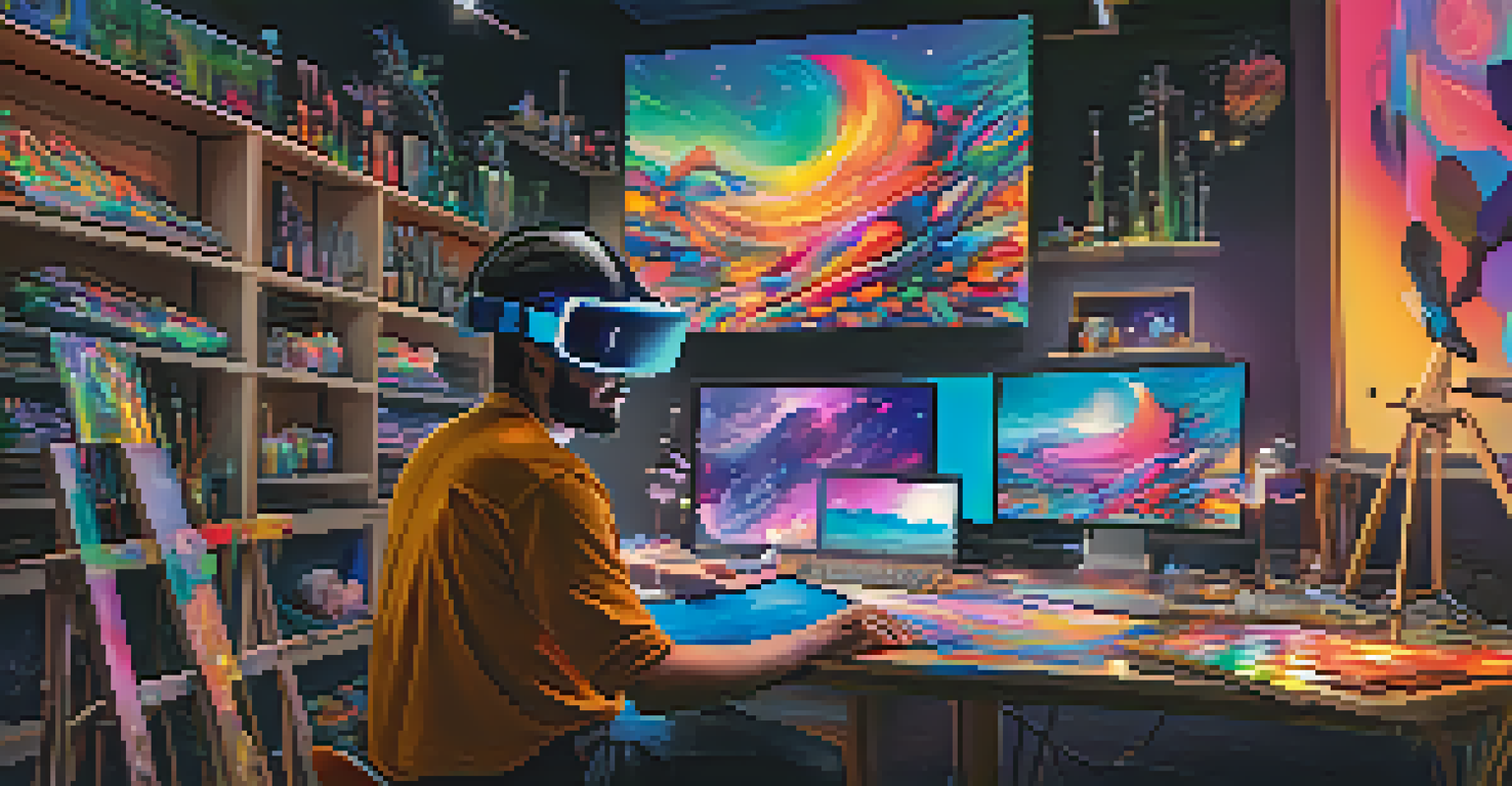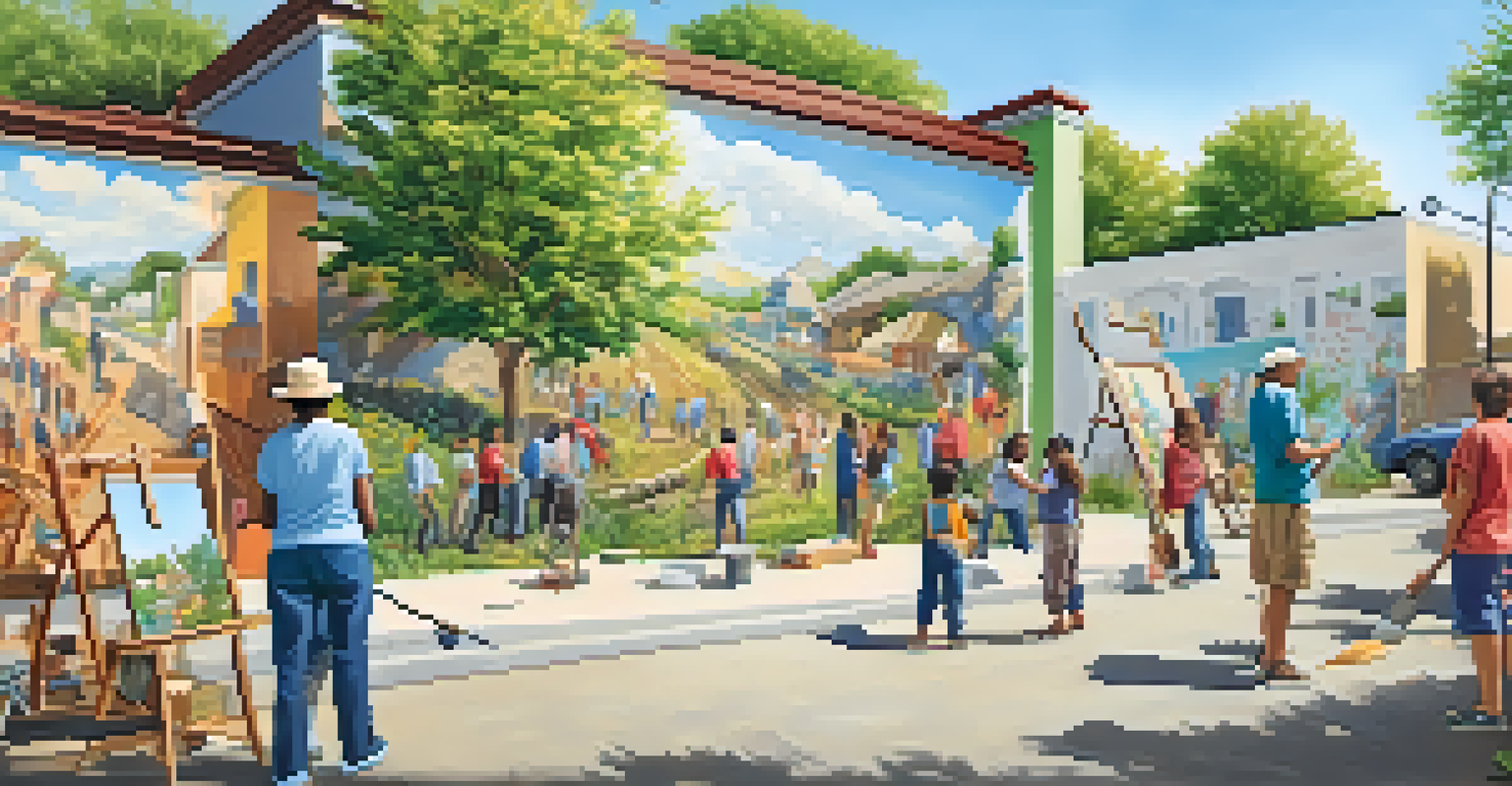Collaborative Art Projects: A Product of Globalization

Understanding Collaborative Art in a Global Context
Collaborative art projects bring together artists from diverse backgrounds, creating a rich tapestry of ideas and expressions. These initiatives often reflect the interconnectedness of our world, showcasing how cultural boundaries can blur through creativity. In a global context, artists collaborate across continents, allowing for a unique fusion of styles and perspectives.
Art is the most beautiful of all lies.
For instance, consider the project 'The Obliteration Room' by Yayoi Kusama, where participants from around the world contributed to transforming a white room into a colorful explosion. This illustrates how collaboration transcends geographical limitations, inviting global participation. Such projects not only highlight artistic innovation but also foster community and dialogue among different cultures.
Ultimately, the essence of collaborative art lies in its ability to unite people through shared experiences and collective creativity. As globalization continues to shape our world, these projects become vital in promoting understanding and appreciation of diverse artistic expressions.
The Role of Technology in Collaborative Art
Technology plays a pivotal role in facilitating collaborative art projects, making it easier for artists to connect and collaborate regardless of location. Online platforms and social media enable artists to share their work, engage in discussions, and even create art in real-time together. This digital landscape expands the possibilities for collaboration, breaking down barriers that once limited artistic partnerships.

Take, for example, the use of virtual reality (VR) in collaborative projects. Artists can immerse themselves in a shared digital space, creating three-dimensional works of art that can be experienced globally. This not only enhances the collaborative experience but also allows for innovative expressions that would be challenging to achieve in traditional settings.
Art Unites Through Global Collaboration
Collaborative art projects bring together diverse artists, showcasing how creativity transcends cultural boundaries.
By leveraging technology, artists can reach wider audiences and create more inclusive projects. As a result, the fusion of art and technology not only enriches the collaborative process but also transforms how we perceive and interact with art in a globalized world.
Cultural Exchange Through Art Collaboration
Collaborative art projects serve as a powerful platform for cultural exchange, allowing artists to share their heritage and traditions with a global audience. These interactions often lead to the blending of artistic styles, resulting in unique creations that reflect multiple influences. This exchange can foster greater understanding and appreciation of different cultures, enriching the artistic landscape.
Creativity takes courage.
For instance, the 'Art for Refugees' initiative brings together artists from various backgrounds to create works that highlight the experiences of displaced individuals. Through this collaborative effort, artists not only showcase their talents but also raise awareness about important social issues. Such projects highlight the potential of art to bridge cultural gaps and stimulate dialogue on pressing global challenges.
In this way, collaborative art becomes a vehicle for storytelling, allowing artists to share their narratives while inviting others to contribute their perspectives. This dynamic interaction cultivates a sense of unity and empathy, demonstrating the transformative power of art in a globalized society.
The Impact of Globalization on Artistic Styles
Globalization has significantly influenced artistic styles, leading to the emergence of hybrid forms that reflect the fusion of different cultural elements. As artists collaborate across borders, they often incorporate diverse techniques and materials into their work, resulting in innovative creations that challenge traditional norms. This blending of styles not only enriches the art world but also invites audiences to engage with art in new ways.
A great example is the 'Street Art World' project, where urban artists from various countries collaborated to create murals that reflect their unique cultural backgrounds. This initiative highlights how globalization can inspire artists to experiment with their craft, resulting in vibrant, thought-provoking works that resonate on multiple levels. The accessibility of information and resources has also encouraged artists to explore and adopt influences from different cultures.
Technology Enhances Artistic Connections
Advancements in technology facilitate real-time collaboration, allowing artists to connect and create regardless of geographical limitations.
Consequently, globalization acts as a catalyst for artistic evolution, prompting artists to push boundaries and redefine what art can be. This dynamic interchange not only enhances individual creativity but also enriches the global art community as a whole.
Community Engagement and Collaborative Art
Many collaborative art projects emphasize community engagement, inviting local residents to participate in the creative process. This approach fosters a sense of ownership and pride among community members, often resulting in art that resonates deeply with its audience. By involving diverse voices in the creation of art, these projects can reflect the complexities of the communities they represent.
An example of this is the 'Community Murals' project, where artists collaborate with locals to design and paint murals that tell the story of their neighborhood. Such initiatives not only beautify public spaces but also strengthen community bonds and encourage dialogue about shared experiences and challenges. This participatory approach transforms art into a communal activity, breaking down barriers between artists and audiences.
Ultimately, community engagement in collaborative art projects highlights the importance of inclusivity and representation in the creative process. By valuing diverse perspectives, these projects enrich the artistic landscape and create meaningful connections that extend beyond the canvas.
Challenges Faced in Collaborative Art Projects
While collaborative art projects offer numerous benefits, they also come with their fair share of challenges. Coordinating between artists from different cultural backgrounds can lead to misunderstandings or conflicts, especially when it comes to creative visions and expectations. Navigating these complexities requires open communication and a willingness to compromise, which can be difficult in a collaborative setting.
For instance, language barriers can pose a significant hurdle in international projects, making it challenging for artists to express their ideas and intentions clearly. This can lead to frustration and hinder the creative process, potentially stifling the collaborative spirit. However, many artists and facilitators actively work to overcome these challenges by employing translators or using visual methods to communicate.
Cultural Exchange Enriches Art
Through collaborative efforts, artists blend styles and share narratives, promoting understanding and appreciation of different cultures.
Despite these obstacles, the rewards of collaboration often outweigh the difficulties. By addressing challenges head-on, artists can cultivate resilience and adaptability, ultimately enriching their collaborative experiences and producing artworks that reflect their collective journey.
The Future of Collaborative Art in a Globalized World
Looking ahead, the future of collaborative art projects appears promising as globalization continues to evolve. Artists are increasingly recognizing the value of cross-cultural collaboration, leading to innovative projects that challenge conventional artistic boundaries. With the ongoing advancements in technology and communication, the potential for collaboration will only expand, inviting even more diverse voices into the creative process.
Moreover, as social and environmental issues become more pressing, collaborative art projects can play a significant role in raising awareness and inspiring action. Artists can unite to address topics such as climate change, social justice, and human rights, using their collective power to provoke thought and encourage dialogue. This shift towards socially engaged art will further enhance the relevance of collaborative projects in today’s world.

In conclusion, the future of collaborative art is bright, fueled by the spirit of innovation and the desire for connection. As artists continue to work together across borders, they will undoubtedly create meaningful, impactful works that resonate with audiences worldwide, celebrating the beauty of diversity in a globalized society.